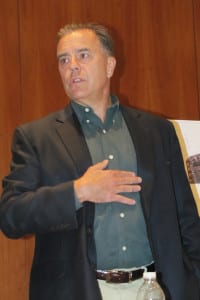The Huntington Town Board hired an outside attorney on Tuesday to investigate legal issues surrounding an East Northport rental property that Councilman Gene Cook (I) partially owns.
The board’s Democrats — Supervisor Frank Petrone, Councilwoman Susan Berland, Councilman Mark Cuthbertson and Councilwoman Tracey Edwards — voted in favor of the move. Cook recused himself from the vote.
The resolution follows recent reports in local newspapers the Observer and the Long Islander that focus on the Larkfield Road property Cook co-owns with attorney Josh Price and Huntington real estate agent Tim Cavanaugh. The property, which contains five apartment units in one structure, was written up on a town code violation late last year stemming from work that was done on the site in October.
The property is in a single-family zoning district but the owners claim the house predates Huntington Town enacting a building and zoning code in 1934, and point to a 1997 town document indicating that. The document, known as a letter in lieu of a certificate of occupancy, is issued to properties formed before the town began to issue those certificates. But the property has been on the Department of Public Safety’s radar for various issues, according to town files — most recently in October, over whether work done there had proper building permits. A town inspector told a previous owner that the occupancy document “does not designate use of the structure and that he must go to the [Zoning Board of Appeals] for the use of a five-family dwelling,” according to a town document.
At Tuesday night’s meeting, Cook labeled the board’s appointing a special attorney “political payback.” He also noted the town has not issued him a summons to appear in court on any charges. Cook, the board’s minority member who caucuses with the local GOP, is seeking re-election to his seat this year.
Meanwhile, Petrone, who proposed hiring the attorney with a second from Cuthbertson, said the town needed to hire outside counsel to look into the matter.
“The intent is to resolve this.”
According to the resolution, the situation has “created a conflict which precludes the town attorney’s office from investigating further and which requires recusal of the town attorney’s office.”
Petrone said that is to be expected when an investigation involves a board member.
“If there is a violation, or anything that comes forward on a board member, we cannot really investigate the situation or even try to negotiate it out, because it’s a board member that really acts, votes on budgets and votes on the individuals that would be looked at for the solution to a problem,” he said to reporters after the meeting. “So you normally bring in someone from the outside, and that’s what this is for — bring someone in, bring them together, to hopefully resolve whatever the issue is.”
When reached on Wednesday, Price said he felt the situation was politically motivated.
“This is truly an example of a municipality using taxpayer dollars to go after its political enemy for no other reason than that they’re trying to win an election this year and it offends me to the very core,” he said.
The situation was brought up with the town’s ethics board at its annual meeting earlier this year. Northport resident Sherry Pavone read from a letter saying the town’s ethics code needs to be enhanced with regard to town board members disclosing relationships with individuals they recommend for appointments to the town’s decision-making boards. She was speaking specifically about Price, who Cook sought unsuccessfully to appoint to the town’s ZBA last year, and said Cook should have disclosed that he and Price were partners in a limited liability company that owns the multifamily home before moving to make the appointment.
The board hired attorney Edward Guardaro Jr., of the firm Kaufman, Borgeest & Ryan LLP, to look into the East Northport house case. The town is paying $200 per hour out of its operating budget.
Guardaro, who has worked with the town before, didn’t immediately return a call seeking comment.











